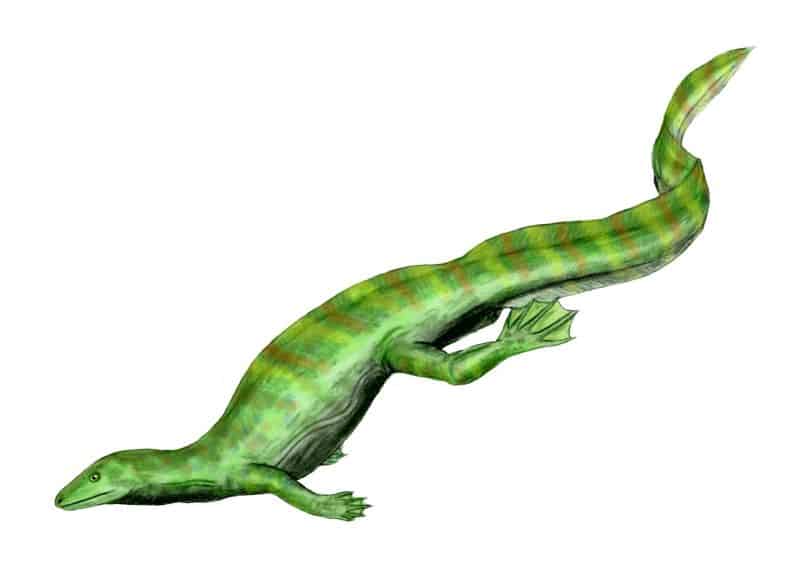Throughout the evolutionary history of life on earth, there have been some pretty strange creatures. If you tried to make a creature as strange as a platypus, for example, you just can’t think of anything that comes close! A few hundred million years ago, a creature lived before the dinosaurs roamed the earth, and it was strange enough to have “platypus status.” Today, we are going to learn all about the foot-long reptile with webbed feet, a snake’s tail, and a lizard’s head!
Hovasaurus, the strange reptile that lived before the time of the dinosaurs.
Hovasaurus is an extinct genus of reptiles that belonged to the diapsid clade in the Eosuchia order.
A genus is a related group of creatures, and hovasaurus would have been a larger group of related lizards that all had similar traits and features. These ancient creatures were among the first reptiles to have ever appeared, with the first reptiles only appearing 100 million years before hovasaurus.
Hovasaurus belonged to the diapsid clade, which translates to “two arches” in a reference to the two holes on each side of their skulls. Although hovasaurus is no longer around, diapsids still are! In fact, all modern reptiles, birds, and even turtles are diapsids and have carried on nearly 250 million years later as a related descendant of hovasaurus. This group is extremely diverse, with some 17,000 or more species still alive today.
What did Hovasaurus look like?

Hovasaurus lived a semi-aquatic or totally aquatic life.
© – License
Hovasaurus was a strange lizard. It would have been a smaller, slender lizard, probably around 3-feet from head to tail. Its head looked like a typical lizard head, but it also had webbed feet like a duck and a vertically flattened tail like a tadpole or a sea snake.
These adaptations allowed hovasaurus to live a semi-aquatic or totally aquatic life. Researchers have a clear picture as to what hovasaurus looked like because of how common the fossils are discovered during digs.
When and where did Hovasaurus live?
Hovasaurus is an extremely old reptile. They first appeared in the fossil record during the Late Permian period and went extinct during the Early Triassic period, spanning a time from roughly 252 million years ago to 247 million years ago. Hovasaurus would have been quite numerous, especially judging from how many fossils are uncovered of various members of the hovasaurus genus.
Hovasaurus survived quite a lot and is recorded as having made it through the Permian-Triassic extinction event. This extinction event was so widespread that its pop name is The Great Dying. It is regarded as the most severe extinction event known to humans and resulted in the extinction of 81% of all marine species, 70% of all terrestrial vertebrate species, and 57% of all biological families. Even more, it was the largest known mass extinction of insects. Hovasaurus made it through it all!
During its roughly 5 million-year-long existence, hovasaurus lived in what is now modern-day Madagascar. This region would have been a wetland environment within a rift valley. The weather would have been warm and humid, perfect for a smaller reptile. Scientists believe that hovasaurus was an aquatic reptile, especially when looking at its tail and webbed feet.
What did Hovasaurus eat?
Hovasaurus would have been primarily piscivorous, meaning it ate fish. As an aquatic lizard, hovasaurus would have spent most of its time hunting in the water, hoping to use its powerful tail and webbed feet to nimble move around in the water. Its tail is laterally flattened and looks extremely similar to modern-day sea snakes. This adaptation is ideal for animals who spend a lot of time in the water and need bursts of speed. Crocodiles and alligators have similar tails, only more heavily armored and thicker.
Incredibly, multiple fossils have been found that show hovasaurus with stones in its stomach. Researchers believe these stones were used as ballast. In order to more easily sink and catch fish, hovasaurus would swallow stones to stop itself from floating.
Up Next:
- Meet Every Dinosaur Featured in Jurassic World Dominion (30 Total)
- Meet the Large Dinosaur Discovered by 7-Year-Old
- Are Dinosaurs Reptiles?
The photo featured at the top of this post is © – License / Original
Sources
- Prehistoric Wildlife, Available here: http://www.prehistoric-wildlife.com/species/h/hovasaurus.html
Thank you for reading! Have some feedback for us? Contact the AZ Animals editorial team.






